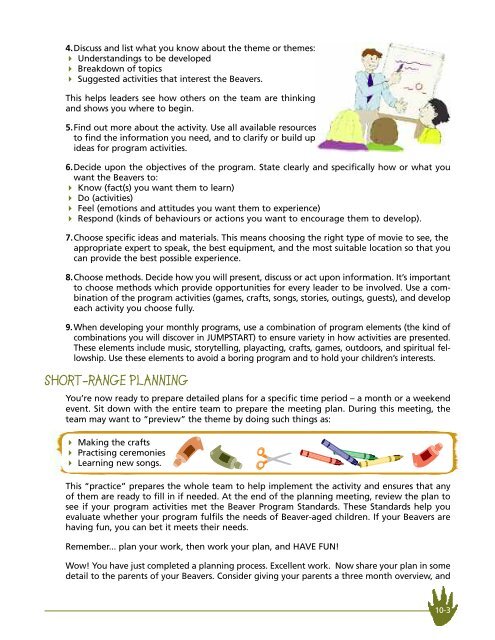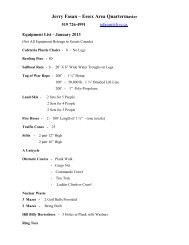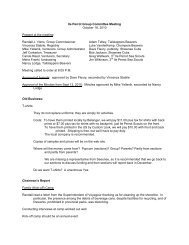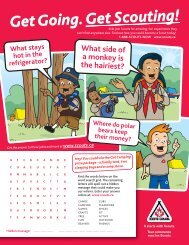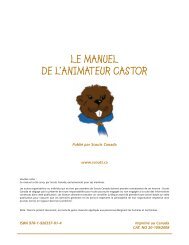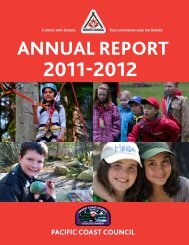Beaver Leader's Handbook - Scouts Canada
Beaver Leader's Handbook - Scouts Canada
Beaver Leader's Handbook - Scouts Canada
You also want an ePaper? Increase the reach of your titles
YUMPU automatically turns print PDFs into web optimized ePapers that Google loves.
4.Discuss and list what you know about the theme or themes:<br />
4 Understandings to be developed<br />
4 Breakdown of topics<br />
4 Suggested activities that interest the <strong>Beaver</strong>s.<br />
This helps leaders see how others on the team are thinking<br />
and shows you where to begin.<br />
5.Find out more about the activity. Use all available resources<br />
to find the information you need, and to clarify or build up<br />
ideas for program activities.<br />
6.Decide upon the objectives of the program. State clearly and specifically how or what you<br />
want the <strong>Beaver</strong>s to:<br />
4 Know (fact(s) you want them to learn)<br />
4 Do (activities)<br />
4 Feel (emotions and attitudes you want them to experience)<br />
4 Respond (kinds of behaviours or actions you want to encourage them to develop).<br />
7.Choose specific ideas and materials. This means choosing the right type of movie to see, the<br />
appropriate expert to speak, the best equipment, and the most suitable location so that you<br />
can provide the best possible experience.<br />
8.Choose methods. Decide how you will present, discuss or act upon information. It’s important<br />
to choose methods which provide opportunities for every leader to be involved. Use a combination<br />
of the program activities (games, crafts, songs, stories, outings, guests), and develop<br />
each activity you choose fully.<br />
9.When developing your monthly programs, use a combination of program elements (the kind of<br />
combinations you will discover in JUMPSTART) to ensure variety in how activities are presented.<br />
These elements include music, storytelling, playacting, crafts, games, outdoors, and spiritual fellowship.<br />
Use these elements to avoid a boring program and to hold your children’s interests.<br />
SHORT-RANGE PLANNING<br />
You’re now ready to prepare detailed plans for a specific time period – a month or a weekend<br />
event. Sit down with the entire team to prepare the meeting plan. During this meeting, the<br />
team may want to “preview” the theme by doing such things as:<br />
4 Making the crafts<br />
4 Practising ceremonies<br />
4 Learning new songs.<br />
This “practice” prepares the whole team to help implement the activity and ensures that any<br />
of them are ready to fill in if needed. At the end of the planning meeting, review the plan to<br />
see if your program activities met the <strong>Beaver</strong> Program Standards. These Standards help you<br />
evaluate whether your program fulfils the needs of <strong>Beaver</strong>-aged children. If your <strong>Beaver</strong>s are<br />
having fun, you can bet it meets their needs.<br />
Remember... plan your work, then work your plan, and HAVE FUN!<br />
Wow! You have just completed a planning process. Excellent work. Now share your plan in some<br />
detail to the parents of your <strong>Beaver</strong>s. Consider giving your parents a three month overview, and<br />
10-3


